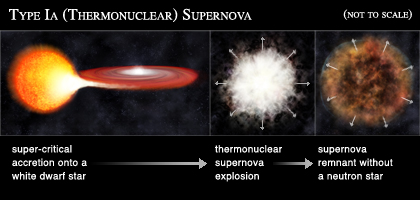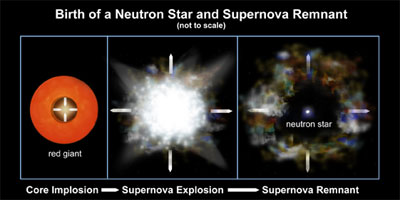 Aquí apreciamos unas bellas vistas de los remanentes de la gran explosión de la Supernova de Kepler, captadas por el Observatorio de Rayos - X "'Chandra". Fuente:NASA
Aquí apreciamos unas bellas vistas de los remanentes de la gran explosión de la Supernova de Kepler, captadas por el Observatorio de Rayos - X "'Chandra". Fuente:NASAHola amigos: A VUELO DE UN QUINDE EL BLOG., acabamos de recibir de la NASA, dos bellas fotos de lo que fueron los remanentes de la gran explosión de la Supernova de "Kepler", captadas por el Observatorio de Rayos - X "Chandra". Esta Supernova fue descubierta el 9 de octubre de 1,604 , por el astrónomo alemán Johannes Kepler, se le denomina: SN 1604, está a unos 20,000 años de La Tierra. Estuvo en nuestra Vía Láctea, en la Constelación de Ophiuchus.
Versión de la NASA
In English:
These two supernova remnants are part of a new study from NASA's Chandra X-ray Observatory that shows how the shape of the remnant is connected to the way the progenitor star exploded. In this study, a team of researchers examined the shapes of 17 supernova remnants in both the Milky Way galaxy and a neighbor galaxy, the Large Magellanic Cloud.
The results revealed that one category of supernova explosion, known as "Type Ia," generated a very symmetric, circular remnant. This type of supernova is thought to be caused by a thermonuclear explosion of a white dwarf, and is often used by astronomers as a "standard candle" for measuring cosmic distances. The image in the right panel, the so-called Kepler supernova remnant, represents this type of supernova.
generated a very symmetric, circular remnant. This type of supernova is thought to be caused by a thermonuclear explosion of a white dwarf, and is often used by astronomers as a "standard candle" for measuring cosmic distances. The image in the right panel, the so-called Kepler supernova remnant, represents this type of supernova.
On the other hand, remnants tied to the "core collapse" family of supernova explosions were distinctly more asymmetric, which is seen in the morphology of the G292.0+1.8 remnant (left). The research team measured asymmetry in two ways: how spherical or elliptical the supernova remnant was and how much one side of the remnant mirrors its opposite side. In G292, the asymmetry is subtle but can be seen in elongated features defined by the brightest emission (colored white).
family of supernova explosions were distinctly more asymmetric, which is seen in the morphology of the G292.0+1.8 remnant (left). The research team measured asymmetry in two ways: how spherical or elliptical the supernova remnant was and how much one side of the remnant mirrors its opposite side. In G292, the asymmetry is subtle but can be seen in elongated features defined by the brightest emission (colored white).
Out of the 17 supernova remnants sampled, ten were independently classified as the core-collapse variety, while the remaining seven of them were classified as Type Ia. One of these, a remnant known as SNR 0548-70.4, was a bit of an "oddball". This one was considered a Type Ia based on its chemical abundances, but has the asymmetry of a core-collapse remnant.
Guillermo Gonzalo Sánchez Achutegui
ayabaca@hotmail.com
ayabaca@gmail.com
ayabaca@yahoo.com

1 comentario:
Que impresionante y bella supernova!!!!!!!!!
Publicar un comentario